

|
| POLSKA | POLAND |
| województwo: Dolnośląskie | voivodship: Lower Silesia |
| miasto na prawach powiatu: Legnica | city: Legnica |
Legnica is situated at an elevation of 108 m on the Kaczawa river in the voivodship Lower Silesia, about 60 km west of the voivodship's capital, Wrocław. As of the census of 2005 the city has a total population of about 106,100.
The settlement presumably was founded in the 7th century and was first mentioned in chronicles from 1004. Legnica derives its name from either the Polish verb leżeć or the German verb liegen ("to lie" [lie-lay-lain]) and was originally known as Lignica. The town became the residence of the dukes of Lower Silesia in 1163 and was the seat of a principality ruled by a branch of the Piast dynasty from 1248 until 1675. Along with other Silesian duchies, Lignica became a vassal of the Kingdom of Bohemia during the 14th century and was included within the Holy Roman Empire. After the death of King Louis II of Hungary and Bohemia at Mohács in 1526, Lignica was inherited by the Habsburg Monarchy of Austria. In 1676, Lignica passed to direct Habsburg rule after the death of the last Piast duke, Georg Wilhelm of Liegnitz-Brieg-Wohlau (Legnica-Brzeg-Wołów). The town became increasingly Germanised and known by the German name Liegnitz. In 1742 Liegnitz became part of the Kingdom of Prussia after Austria's defeat in the War of the Austrian Succession. The census of 1910 gave Liegnitz's population as 95.86% German, 0.15% German and Polish, 1.27% Polish, 2.26% Wendish, and 0.19% Czechs. After the defeat of Nazi Germany in World War II, Liegnitz was transferred to Poland following the Potsdam Conference in 1945. The German population was expelled from 1945–1947 and the town was renamed Legnica.
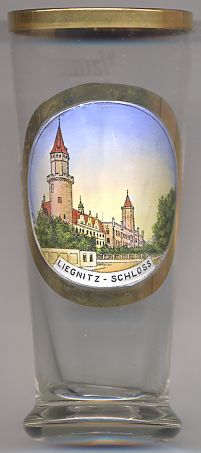
The  Piast castle [left, no. 2225] was first built between 1201 and 1238.
The lower parts of the two towers (Hedwig's Tower on the left, Peter's Tower on the right) date from this period.
It was converted into a Renaissance palace in the mid-16th century for the Piast dukes of Silesia-Brieg (Brzeg), whose line
died out in 1675. After the castle had been badly damaged by fire in the 1830s, it was rebuilt in the neo-Gothic style
by the German architect Karl Friedrich Schinkel.
Piast castle [left, no. 2225] was first built between 1201 and 1238.
The lower parts of the two towers (Hedwig's Tower on the left, Peter's Tower on the right) date from this period.
It was converted into a Renaissance palace in the mid-16th century for the Piast dukes of Silesia-Brieg (Brzeg), whose line
died out in 1675. After the castle had been badly damaged by fire in the 1830s, it was rebuilt in the neo-Gothic style
by the German architect Karl Friedrich Schinkel.
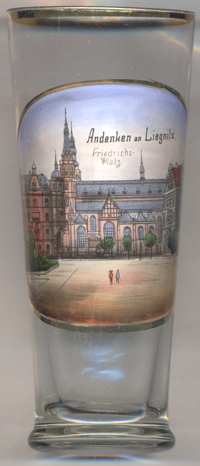
The  cathedral St. Peter and Paul [near left, no. 3180]
in Friedrichsplatz (today Plac Słowiański) was built in 1329–1390. Several times during its history
it had to be rebuilt,
cathedral St. Peter and Paul [near left, no. 3180]
in Friedrichsplatz (today Plac Słowiański) was built in 1329–1390. Several times during its history
it had to be rebuilt,
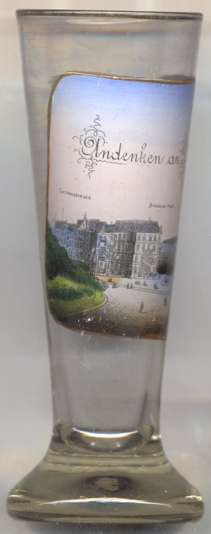
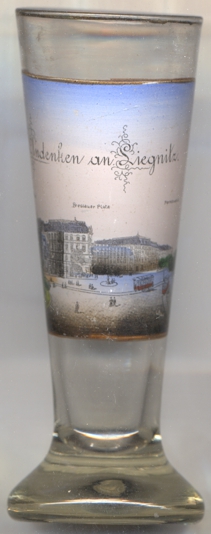
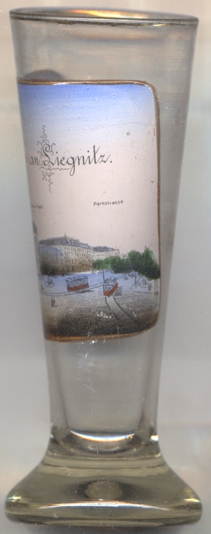
The picture on glass no. 4132 [near left] shows a view of the intersection of
 Gartenstraße
Gartenstraße Parkstraße
Parkstraße Brelauer Platz
Brelauer Platz
[http://en.wikipedia.org/wiki/Legnica, https://de.wikipedia.org/wiki/Legnica,
http://www.heritagesites.eu.com/poland/legnica.htm, https://de.wikipedia.org/wiki/Bistum_Legnica;
https://polska-org.pl/978514,foto.html?idEntity=591825]
![[scale]](lineal.jpg)